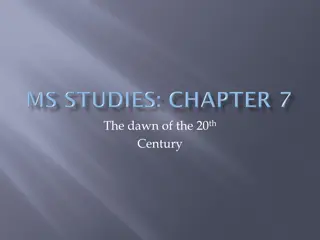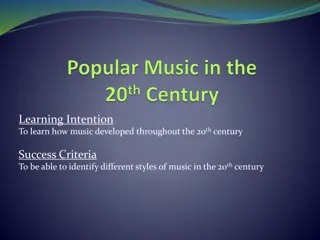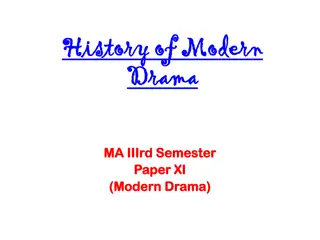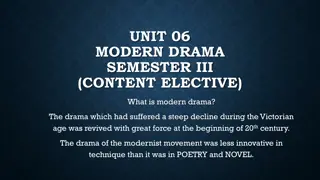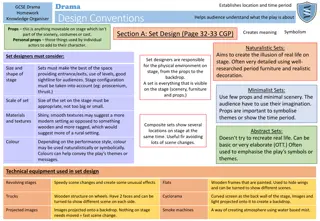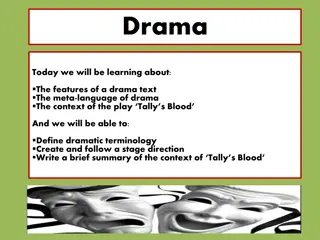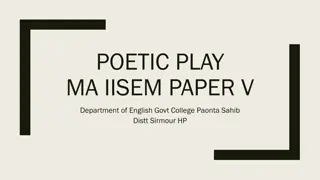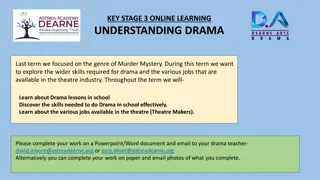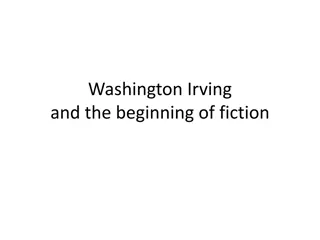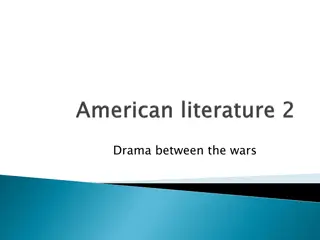
Exploring Expressionism in 20th Century American Drama
Discover the influence of German playwrights, the essence of Expressionism, and its impact on American dramatists like Eugene O'Neill. Dive into the world of bold theatrical styles and psychological exploration as we unravel the roots of this artistic movement in the realm of theatre.
Download Presentation

Please find below an Image/Link to download the presentation.
The content on the website is provided AS IS for your information and personal use only. It may not be sold, licensed, or shared on other websites without obtaining consent from the author. If you encounter any issues during the download, it is possible that the publisher has removed the file from their server.
You are allowed to download the files provided on this website for personal or commercial use, subject to the condition that they are used lawfully. All files are the property of their respective owners.
The content on the website is provided AS IS for your information and personal use only. It may not be sold, licensed, or shared on other websites without obtaining consent from the author.
E N D
Presentation Transcript
Expressionism in 20thCentury American Drama Dr. Lakshmi Muthukumar, Head, Dept. of English Material for Semester 4 2019-20
1920s Though realism was still considered a new style in early 20thcentury theatre, by the 1920s, American playwrights had beyond realistic their characters tortured lives. begun surfaces inward, to look toward often
Influenced and inspired by: German playwrights and directors in the era just beyond the First World War Driven by the same need to explore the human psyche found in painters such as Vincent Van Gogh and Edvard Munch Theorists such as Carl Jung and Sigmund Freud A German film The Cabinet of Dr. Caligari (1919) was also an influence
What is Expressionism? Expressionism tried to convey inner psychological and emotional states through: Boldly distorted sets Stylized dialogue Nightmarish distortions Strange angles Jarring sounds and staccato speech Briskly episodic plots
Expressionism attempted to give voice to anxieties created by an increasing sense that life had become inhumanely fast, mechanized, and impersonal, dominated by the very technology that was supposed to liberate humanity.
Leading American dramatists who used Expressionism Eugene O Neill Elmer Rice John Howard Lawson Sophie Treadwell
The Influence of German Playwrights Walter Hasenclever Ernst Toller Georg Kaiser These three German playwrights produced a body of plays between 1914 and 1922 that established expressionism not only as a bold theatrical style but also as a mode of political and cultural criticism.
The influence of August Strindberg The origin of expressionism in theatre is usually traced to the later plays of the Swedish playwright August Strindberg, especially his radically non-realistic A Dream Play (1902) and The Ghost Sonata (1907).
The Dream in Expressionistic Plays In Strindberg s preface to The Ghost Sonata he explains: the dream is a heightened reality in which a single consciousness is fractured, liberated from everyday realities and logic, but tormented by its own hidden anxieties . Expressionistic plays offered an alternative to the social realism of Ibsen and his admirers, appealing especially to those who wished to explore what Nietzche had called the Dionysian forces in art and life.
EUGENE ONEILL (1888-1953) The playwright who transformed American drama from an entertainment to a serious literary form
Seminal Expressionistic Plays by ONeill The Emperor Jones (1920) The Hairy Ape (1922) All God s Chillun Got Wings (1924) Desire Under the Elms (1924) The Great God Brown (1926) Days Without End (1933) O Neill also wrote the brief Memoranda on Masks - a key text in the theory of expressionistic staging in 1932.
Elmer Rice (born Reizenstein) (1892-1967) His first great success was the play On Trial (1914) Another play which has been frequently anthologized is The Adding Machine (1921) An expressionistic satire on the dehumanization of Mr. Zero by technology. The Subway (1929) mingled expressionism with naturalism Street Scene (1929) his best play for which he was awarded the Pulitzer prize and See Naples and Die (1929) a good humoured farce
The Adding Machine- presented broader carricatures of modern life Mr. Zero is a bookkeeper who is fired and this prompts him to murder his boss. Mr. Zero is first shown in a confining room lined with the foolscap sheets used in his trade, suggesting a life without joy or escape. A full range of visual, aural, and mechanical effects are deployed to convey the disorder of Mr. Zero s psyche, including loud music, distorted scenery, swirling lights, and a spinning platform built into the office floor.
Sophie Treadwell (1885-1970) Plays: Gringo (1922) based on her experiences in Mexico O Nightingale (1925) a comedy about a stage- struck young woman Machinal (1928) based on a sensational murder trial. For Saxophone (1934) which heavily relied on music and dance and the voices of unseen characters to tell the story of another young woman trapped in a marriage of convenience Plumes in the Dust (1936) based on the life of Edgar Allen Poe Rights (1921) an unproduced drama on the life of 18thcentury feminist Mary Wollstonecraft Ladies Leave (1929) a seriocomic look at a young woman s attempt to enliven her marriage by taking a lover. Hope for a Harvest (1941) exposes prejudice and environmental destruction in her native California.
Machinal Written in the expressionistic style Machinal , tells the story of a sensitive young woman who desperately tries to find happiness in a mechanized, male-dominated world. The play featured flat, symbolic characters as well as repetitive dialogue and action.



